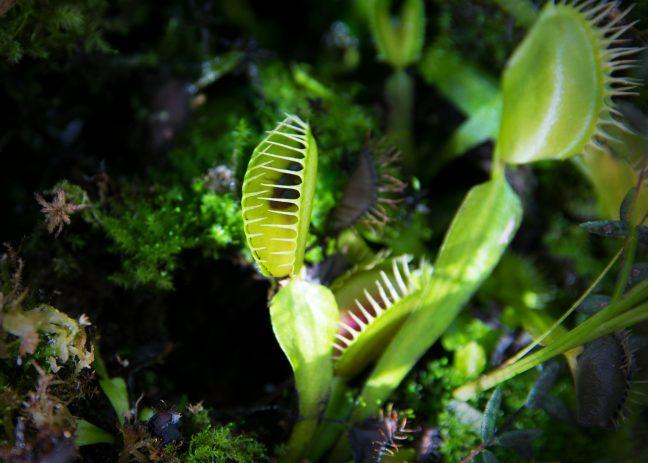With around only 20 sustainable populations of Venus flytraps left in the world, the well-known carnivorous plant could be at the brink of extinction within the next century.
Two University of Wisconsin scientists are working to prevent that.
UW botany and environmental studies professor Don Waller and UW Botany Department honorary fellow Thomas Gibson spearheaded an emergency petition in Oct. 21 to grant Venus flytraps protection under the Endangered Species Act. In addition to the petition, which was submitted to the U.S. Fish and Wildlife Service, Waller and Gibson are pushing for increased support from the public and federal government.

Riley Steinbrenner/The Badger Herald
Currently, there are only about 10 to 20 sustainable populations of flytraps left in the world, with a population ranging in size from a dozen to several thousand flytraps per population.
“[The flytrap] is as American as the bald eagle,” Waller said. “It’s from our own backyard, why aren’t we protecting it?”
The protection provided by the Endangered Species Act would restrict people from taking flytraps from their native habitats and make it illegal to construct developments over wild populations of the plant.
Vilas Zoo adopts cuddly duo in effort to protect endangered species
The two most-detrimental human threats to Venus flytraps, Waller said, are poaching and habitat destruction.
Just last year, poachers uprooted 970 flytraps — three percent of the wild population — from their native region of eastern North Carolina.
Over the summer, new development around Wilmington, North Carolina leveled five flytrap populations on federal land, allegedly by mistake, Waller said.
“The fact that that kind of thing can happen … to me just signaled that this species is in desperate need of protection,” Waller said.
Many UW professors and even world-renowned botanists, such as Peter Raven of the Missouri Botanical Garden, have already pledged their commitment to reduce the flytrap’s imminent threat of extinction by signing the petition.
But the process is far from over.
After the petition is submitted, the U.S. Fish and Wildlife Service has 90 days to make a decision on whether or not the data put together by Waller supports the need to list Venus flytraps as endangered. This means a ruling on Waller’s petition must be made by January 19, 2017.
After the ruling is made, it could take anywhere from 12 months to 10 years to list the Venus Flytrap as endangered.
“We have a lot of faith in the government but things are really slow,” Waller said. “Flytraps will be even more decimated in numbers if we have to wait 10 to 20 years.”
Because of this, Waller and Gibson believe the public should get involved now by signing their own petition on Change.org to provide even more advocacy to save this well-known, but often misconstrued, species.
The “world’s most wonderful plant,” as Charles Darwin once referred to them, is native to the barren savannas of North Carolina.
Contrary to the popular misconception of its tropical origins, flytraps — though exotic — flourish solely on American soil. Gibson said if people knew this, they would be more likely to advocate for them.
“I believe strongly that most people would care about the fate of the plant if they knew more,” Gibson said.
The Venus flytrap has only evolved once in the 3.7 billion-year history of Earth to form its recognizable hinged leaves, which enable the meat-eating plant to imprison curious insects in a tenth of a second, Waller said.
This mechanism is especially vital in capturing larger insects that serve as the flytrap’s main source of nutrients, Waller said, setting them apart from most plants with sunlight diets that favor nutrient-rich soils.
An equally important and perhaps more insidious requirement for the survival of flytraps are fires, Waller said. When habitats catch fire, it rids the coastal-Carolina soil of nutrients, causing competing plants to die, allowing more sunlight to reach the Venus flytraps.
The problem is that nature conservancies, such as the one that manages the Green Swamp in North Carolina, are not burning these habitats often enough.
“The only way to maintain flytraps is with fires,” Waller said. “Where there are fires there are flytraps.”
Though there are less flytraps in the wild than in captivity — about 32,000 to one million, respectively — Gibson doesn’t discourage people from purchasing the plants. He hopes people would be willing to pay a “voluntary premium” on flytrap sales which could fund the conservation of wild populations, an idea he hopes will be put into action.
In the future, Waller believes a visitor’s center built around wild flytrap populations in their native Wilmington, North Carolina, could prevent poachers from stealing them in a likely high-traffic tourist attraction.
“The flytrap is a small part of the large and priceless biodiversity of life on earth,” Gibson said.“To [quote] Rachel Carson, ‘But man is a part of nature, and his war against nature is inevitably a war against himself.’”




















